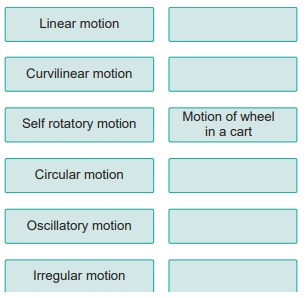Forces and Motion | Term 1 Unit 2 | 6th Science - Questions Answers | 6th Science : Term 1 Unit 2 : Forces and Motion
Chapter: 6th Science : Term 1 Unit 2 : Forces and Motion
Questions Answers
Evaluation
I. Choose the correct answer
1. Unit
of speed is
a. m
b. s
c. kg
d. m/s
Answer: (d) m/s
2. Oscillatory
motion among the following is
a. Rotation of the earth about its axis
b. Revolution of the moon about the earth
c. To and fro movement of a vibrating string
d. All of these.
Answer: (c) To and fro movement of a vibrating string
3. The
correct relation among the following is
1. Speed = distance × time
2. Speed = distance / time.
3. Speed = time / distance
4. Speed = 1 / (distance × time)
Answer: (b) Speed = distance / time
4. Gita
rides with her father’s bike to her uncle’s house which is 40 km away from her
home. She takes 40 minutes to reach there.
Statement
1
: She travels with a speed of 1 km / minute.
Statement
2 :
She travels with a speed of 1 km/hour
a. Statement 1 alone is correct.
b. Statement 2 alone is correct.
c. Both statement 1 and 2 are correct.
d. Neither statement 1 nor statement 2 is correct.
Answer: (a) Statement 1 alone is correct.
II. Find whether the following statements are true or false. if false give the correct answer
1. To and fro motion is called oscill tory motion.
2. Vibratory motion and rotatory motion are
periodic motions.
3. Vehicles moving with varying speeds are said to
be in uniform motion.
4. Robots will replace human in future.
III. Fill in the blanks
1. A
bike moving on a straight road is an example of Linear motion.
2. Gravitational
force is a non-contact force.
3. Motion
of a potter’s wheel is anexample Rotary of motion.
4. When an object covers equal distances in equal interval of time, it is said to be in uniform motion.
IV. Match the following
a. Circular motion, b. oscillatory motion, c. linear motion, d. rotatory motion e. linear and rotatory motion

V. Analogy
1. kicking a ball : contact force :: falling of leaf : _____________
?
kicking a ball : contact force
:: falling of leaf: Non- contact force
2. Distance : metre :: speed : _____________?
Distance :metre :: speed : metre / sec
3. circulatory motion :: a spinning top ::
oscillatory motion : _____________ ?
circulatory motion :: a spinning top :: oscillatory motion : To and fro motion of hand.
VI Given below is the distance-trav-elled by an elephant across
a forest with uniform speed. Com-plete
the data of the table given below with the idea of uniform speed.

VII Complete the web chart

VIII Give one word for the following statements
1. The force which acts on an object without
Physical contact with it Non- contact force.
2. A change in the position of an object with time Motion.
3. The motion which repeats itself after a fixed
interval of time Periodic motion.
4. The motion of an object travels equal distances
in equal intervals of time Uniform motion.
5. A machine capable of carrying out a complex
series of actions automatically.
IX Answer the following in a sen-tence or two
1. Define force.
Answer: push or pull action on an animate or inanimate agency is called force.
2. Name different types of motion based on the
path.
Answer:
• Linear
• Curvilinear
• Circular
• Rotatory
• Oscillatory
• Zigzag (irregular)
3. If you are sitting in a moving car, will you
be at rest or motion with respect ur friend sitting next to you?
Answer: I am in rest respect to my friend sitting next to me.
4. Rotation of the earth is a periodic motion.
Justify.
Answer: For rotation of earth it takes equal interval of time (24 hours)
to rotate itself. So it is a periodic motion.
5. Differentiate between rotational and
curvilinear motion
Answer: Curvilinear - moving ahead but changing direction, like a throwing
ball.
Rotatory -The movement of a body about its own axis, like a rotating
top.
X. Calculate
1. A
vehicle covers a distance of 400km in 5 hour. Calculate its average speed.
Solution:
Average speed (s) = distance travelled (d) / time taken (t)
= 400 km / 5 hour
= 80 km / hour.
XI. Answer in detail:
1. What
is motion? Classify different types of motion with examples.
Answer:
• Motion: Application of force in an object results in motion
from a state of rest. Different-types of motion:
• Linear- moving in a straight line, like a person walking on a
straight path, free fall.
• Curvilinear - moving ahead but changing direction, like a
throwing ball.
• Circular -moving in a circle, swirling stone tied to the rope.
• Rotatory -The movement of a body about its own axis, like a
rotating top.
• Oscillatory -coming back to the same position after a fixed
time interval, like a pendulum.
• Zigzag (irregular) - like the motion of a bee or people
walking in a crowded street.
XII. Fill with examples

Linear motion - walking on a straight path
Curvilinear motion - a throwing ball
Self rotatory motion - Motion
of wheel in a cart
Circular motion - swirling stone tied to the rope
Oscillatory motion - pendulum
Irregular motion people -
walking in a crowded street
Related Topics